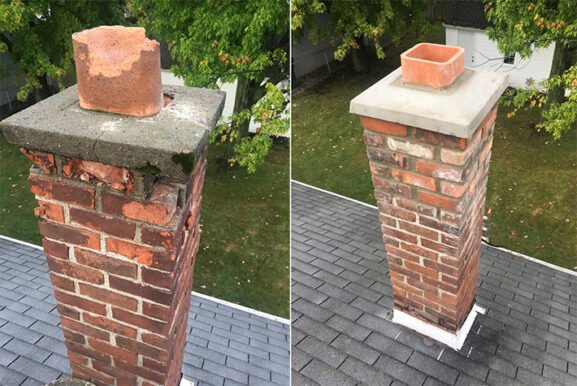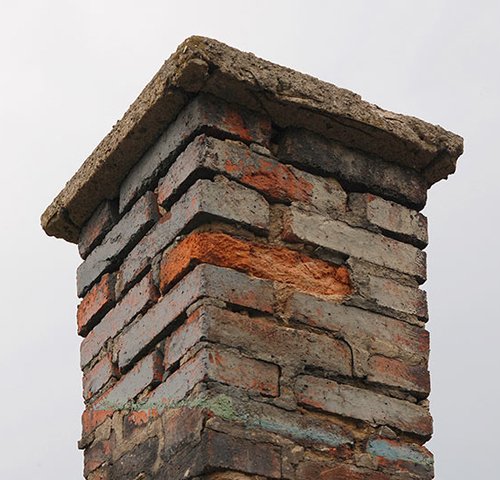Why Homeowners Should Not Ignore Chimney Crown Crack Repair
Key Takeaways
- Cracked chimney crowns allow moisture to seep in, accelerating masonry damage.
- Early repairs prevent costly structural issues down the line.
- Professional assessment helps determine whether patching or full replacement is needed.
- Climate exposure and poor initial construction are common causes of chimney crown cracks.
What the Chimney Crown Does for Your Home
The chimney crown is the concrete or mortar layer at the very top of your chimney, sloping outward to direct water away from the flue and bricks below. While it might seem like a minor feature, it plays a vital role in protecting your chimney from weather-related damage. When the crown cracks, water can penetrate the chimney system, leading to internal damage that’s often hidden until it becomes a major problem.
If left unchecked, chimney crown cracks can lead to moisture infiltration, brick spalling, rusting of the firebox or damper, and even mold development in the interior walls of your home. That’s why regular inspection and timely repair are essential, especially in regions with freeze-thaw weather cycles like New York and New Jersey.
Why Chimney Crown Cracks Happen
Several factors contribute to the formation of cracks in chimney crowns. Understanding them can help you prevent future issues:
- Age and Wear: Over time, exposure to sun, rain, snow, and temperature swings causes concrete or mortar to shrink, crack, and deteriorate.
- Poor Construction: Some crowns are built with the wrong materials or improperly sloped, which makes them more prone to cracking.
- Freeze-Thaw Cycles: In colder climates, water that enters small cracks can freeze, expand, and widen the gaps.
- Lack of Maintenance: Small cracks can quickly worsen if they’re not sealed or monitored during annual chimney inspections.
Not every crack signals an emergency, but all cracks should be taken seriously. Hairline fractures may only need sealing, while deeper cracks might require structural repair or full crown replacement.
Signs of Chimney Crown Damage You Should Watch For
It’s not always easy to see chimney crown damage from ground level, but a few signs could point to underlying problems:
- Pieces of mortar or concrete in the yard or around the chimney base
- Water stains or rust inside the fireplace
- Visible cracks or gaps around the top of the chimney
- Leaks in the attic near the chimney
If you notice any of these issues, a chimney professional should perform a full inspection. Many companies use drones or camera scopes to examine crowns closely without requiring full rooftop access.
Repair Methods Based on Severity
The type of repair your chimney crown needs depends on the size and depth of the cracks. Here’s a closer look at common solutions:
Sealant Application for Minor Cracks
If cracks are narrow and the crown is otherwise structurally sound, a flexible waterproof sealant can be applied to prevent water from entering. These coatings expand and contract with the material to reduce the risk of future cracking. They also add a protective layer against UV damage and rain.
Rebuilding Part of the Crown
When cracks are deeper or cover a larger surface area, the affected portion may need to be removed and rebuilt. This involves chipping away damaged sections, cleaning the surface, and applying fresh mortar or concrete with proper slope and overhang.
Full Crown Replacement
In severe cases, especially where water has already compromised the crown’s base or surrounding brickwork, it’s better to replace the entire crown. This ensures a fresh, solid surface that can last decades with proper care. A quality replacement should include a drip edge and be built with a proper slope to prevent future issues.
According to the Chimney Safety Institute of America (CSIA), chimney crowns should ideally be made from cast-in-place concrete rather than mortar, which is more porous and prone to deterioration over time (source).
How Climate and Location Influence Crown Repairs
Homeowners in areas like the Northeast must be especially cautious about crown cracks. The repeated freezing and thawing during winter accelerates damage. Rainy spring seasons can also introduce a lot of moisture, which seeps into existing fractures and compromises the integrity of your chimney.
If your home is in a region with frequent temperature swings or high precipitation, annual inspections are even more important. These inspections can help catch small cracks before they worsen and identify areas that need sealing, waterproofing, or rebuilding.
Why DIY Repair Isn’t Recommended
While it may be tempting to patch small cracks yourself using store-bought sealants, chimney crown repair is not a standard DIY project. Without proper knowledge of crown construction, sloping, and sealing materials, a temporary fix could make things worse.
Professionals understand which materials are compatible with existing crowns and how to create the correct slope for drainage. They also ensure that work is weatherproof and long-lasting. Attempting repairs without this expertise often leads to incomplete sealing, improper slope, or further cracking.
Hiring a certified chimney technician ensures your repair is done safely and correctly the first time.
Tips for Preventing Future Cracks
Preventive maintenance goes a long way in keeping your chimney crown in good condition. Here are a few expert recommendations:
- Schedule an annual inspection before winter to catch minor issues early.
- Apply a waterproof sealant every few years to protect against moisture damage.
- Make sure your chimney has a cap installed to shield the crown from direct rain and snow.
- Avoid using de-icing chemicals or salt near your chimney, as they can contribute to masonry decay.
Regular upkeep doesn’t just extend the life of your chimney crown; it also protects your entire chimney system from premature deterioration.
Making an Informed Repair Decision
When you notice chimney crown damage, it’s essential to take action rather than wait for symptoms to worsen. A cracked crown can quietly cause thousands of dollars in water damage over time, even if everything looks fine from the outside.
Investing in timely repairs not only safeguards your home’s structure but also improves fireplace safety and efficiency. By partnering with a qualified chimney professional and prioritizing annual maintenance, you can keep your chimney crown in solid shape for years to come.

